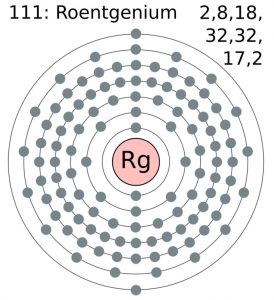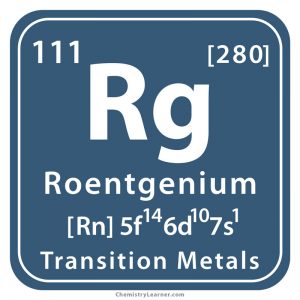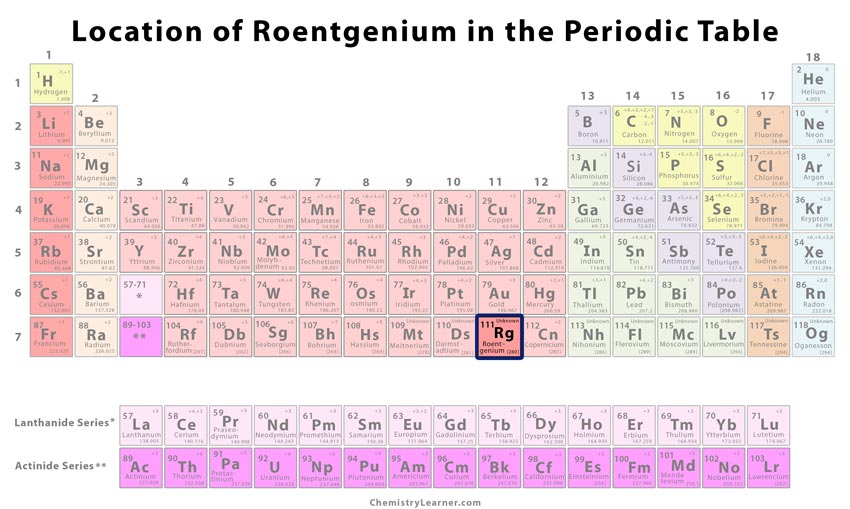Roentgenium
What is Roentgenium
A synthetic radioactive element, roentgenium (pronounced as runt-GEN-ee-əm), also known as unununium, is denoted by the symbol Rg [1, 2]. It is not found naturally and is only produced in the lab under controlled circumstances.
History of Roentgenium
How did the Element get its Name
It is named after Wilhelm Conrad Röentgen, the German physicist and mechanical engineer who first observed X-ray beams [1, 2].
When was Roentgenium Discovered
In 1994, at the GSI Helmholtz Centre for Heavy Ion Research in Darmstadt, Germany, Peter Armbruster, Gottfried Münzenber and their team bombarded atoms of bismuth-209 with ions of nickel-64 using a linear accelerator to produce three atoms of roentgenium-272, having a half-life of 1.5 milliseconds, along with a free neutron [1, 2].
Although seven isotopes of the metal have been synthesized so far, roentgenium-281 is the most stable one with a half-life of 26 seconds after which it decays to meitnerium-276 through spontaneous fission [1, 2, 7].
Classification and Position of Roentgenium in the Periodic Table [1, 2, 4]
| Element Category (Family) | Transition Metal |
| Group | 11 |
| Period | 7 |
| Block | D |
Roentgenium Properties
General Properties |
|
| Atomic Weight | 281 |
| Average Atomic Mass | 272 |
Physical Properties [2, 7, 9] |
|
| Color | Metallic orange (unconfirmed) |
| Odor | Unknown |
| Melting Point | Unknown |
| Boiling Point | Unknown |
| Freezing Point | Unknown |
| Density (g/cm3) | 28.7 (unconfirmed) |
| State of Matter at Room Temperature | Solid (unconfirmed) |
| Malleability | Unknown |
| Hardness | Unknown |
| Electrical Conductivity | Unknown |
Roentgenium Chemical Properties [4] |
|
| Flammability | Unknown |
| Radioactivity | Unknown |
| Oxidation state/Oxidation number | [-1], [+1], [+3], [+5] |
Atomic data of Roentgenium [2, 4, 5]
| Atomic Number | 111 |
| Valence Electrons | 6d107s1 |
| Electron Configuration | [Rn] 5f146d107s1 |
| Atomic Structure | |
| -Number of Electrons | 111 |
| -Number of Protons | 111 |
| -Number of Neutrons | 170 |
| Radius of Atom | |
| -Atomic Radius | 114 |
| -Covalent Radius ((Å)) | 1.21 |
| Electron Affinity | Unknown |
| Electronegativity | Unknown |
| Ionization Energy | Unknown |

Roentgenium Bohr Model
What is Roentgenium Used for
Since it is not found in the environment and is also quite unstable, there are no industrial applications other than being used for basic scientific research. As only a few atoms of the element have been produced, its reactivity with other elements and compounds is unknown [6].
Can the Element be Dangerous
Although the short half-life of Rg does not provide much scope to study its effects on the environment and health, it may be toxic due to its radioactivity when produced in more significant amounts [7].
Interesting Facts
- Rg is believed to exhibit properties similar to gold, silver, ruthenium, and platinum. It even looks somewhat like gold [6, 7]
- In 1986, some physicists at the Russian Joint Institute for Nuclear Research (JINR) had attempted to produce element 111 by bombarding bismuth with nickel but were unable to detect any atoms [2]
- The element is classified as super heavy since it has an atomic number higher than 105 [7]
- The part of the electronic configuration of roentgenium that is equivalent to the noble gas of the preceding period is abbreviated as [Rn] [8]
Roentgenium Cost
The short half-life of the metal does not make it commercially available even today.
- References
- https://education.jlab.org/itselemental/ele111.html
- http://www.rsc.org/periodic-table/element/111/roentgenium
- https://www.livescience.com/41347-facts-about-roentgenium.html
- https://www.chemicool.com/elements/roentgenium.html
- http://www.chemistry.patent-invent.com/chemistry/elements/roentgenium.html
- https://www.webelements.com/roentgenium/chemistry.html
- http://www.elementsdatabase.com/Roentgenium-Rg-111-element/
- https://www.schoolmykids.com/learn/interactive-periodic-table/rg-roentgenium
- https://environmentalchemistry.com/yogi/periodic/mass.html







what is it used for?
It is used for research purposes.